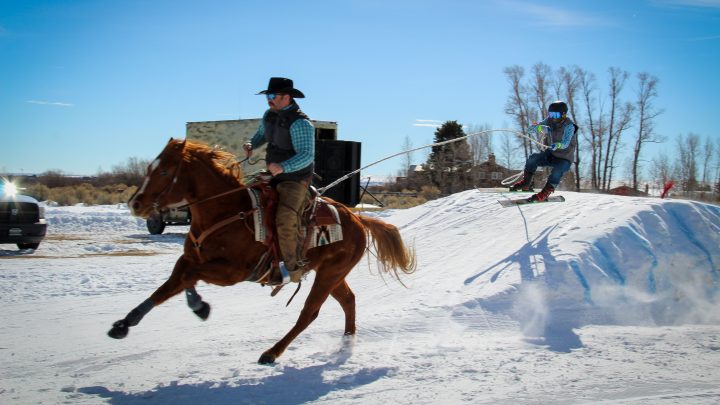
Skijoring brings cowboys and skiers to Western towns, but warm weather leaves the sport in flux
Skijoring brings cowboys and skiers to Western towns, but warm weather leaves the sport in flux

The year was 1949. And some skiers and cowboys were at a bar in Leadville, Colorado. Naturally, the conversation went to “who’s fastest?” The skiers or the cowboys? So they decided to see about it, but as a team. The cowboys pulled the skiers on their horses, literally down Main Street, and that is how what we know today as “skijoring” began in the Rocky Mountain West, at least according to the legend. The name comes from even deeper roots — the Norwegian word for driving, as in “ski driving”.
Over the years, the sport has gained traction, with skijoring races popping up all over the Rocky Mountain West. They bring in lots of money and visitors to small western communities during winter. But, this all depends on snow, and this year, parts of the region have seen unseasonably warm weather.
“Just a rowdy time”
Hundreds of people came out over a recent weekend to watch skijoring at the rodeo grounds in Pinedale, a little mountain town in western Wyoming.
“Lookin’ good guys, lookin’ good,” an announcer cheered on a team. “Let’s go buddy, let’s go.”
A skier whipped around a turn going at least 30 miles per hour, bracing himself for a huge jump. But he is not going downhill — the course is flat. The skier is pulled by a thick rope, attached to a horse barrelling down the track, ridden by a cowboy.
“You got it buddy, you got it. Let’s go, let’s go, let’s go. Cheer ’em on folks, that’s a good run,” the announcer practically screamed into the microphone.
Local skier Sean Boylan waited for his turn on the course, standing by his pickup in snow pants and cowboy boots, sipping a beer.
“A Modelo,” he said. “Helps with the nerves.”
The course itself is snowy, but lining it is dirt and sagebrush. Boylan was worried whether the race would even happen for lack of snow.
“But at the end of the day, it’s kind of just a rowdy time,” Boylan said. “So if you’re skiing through mud, like, oh, well, it’s all good fun.”

A couple weeks ago, event organizer Monte Bolgiano was stressed.
“We were starting to sweat it wondering if we were going to be able to pull it off,” he said.
They used a snow plow to scrounge up snow across town.
“All three inches that were on the ground and we scraped it all up, and were able to make enough to have a course built,” Bolgiano said.
Bolgiano grew up in Pinedale, watching industries like agriculture and energy wax and wane.
“Outside of the little bit of industry that we have here, we are reliant on tourism,” he said.
So on what otherwise would be a slow winter weekend, the skijoring competition is a huge draw.
“Get hotels filled up and restaurants filled up,” Bolgiano said.
He added that businesses saw an 80% boost in traffic over the weekend, which all would have been lost if they had not been able to pull off the event.
“No snow”
The conundrum of holding skijoring on a low snow year has rippled across the West. Normally there are a couple dozen races, but some were called off this year. One in Montana, and several in Wyoming had to be canceled.
“There was no snow, and it was 55, 60 degrees a week before the event,” said Shawn Parker, executive director of Sheridan County Travel and Tourism.
Sheridan is on the other side of Wyoming. Parker said the rural community is known for this winter sport, that is a marriage of cowboying and skiing.
“It’s a big deal,” he said. “I mean, we go from nothing to something and any positive economic stimulus helps.”
Parker noted the town sees more people in one day than in all of February — it means millions of dollars to the local economy. So they tried to make up for it this year by holding concerts and a hockey tournament, but it was not the same.
“We need skijoring to see the really big positive impacts,” said Parker.
Parker added that if these kinds of winters continue, they will need to move the skijoring event out of town and into the mountains where there is more snow.
“Go like hell”
Back in Pinedale, local John Hyde was saddling up his horse Perry in the parking lot. Hyde sported a handlebar mustache and leather chaps. He said he lives and breathes skijoring.
“You get old, you retire from rodeos — have horses might as well use them,” Hyde nodded toward his three horses tied at the trailer.

Hyde’s horse trailer is divided into living quarters for him and space for his horses.
“This now is our home on the road,” he said.
Hyde likes to win and there is often hundreds, if not thousands, of dollars in prize money. Before Hyde and his horse Perry head to the starting line, he shared his hot tip for winning.
“I guess just go like hell,” he said with almost a growl in his voice.
There are skijoring events scheduled across the Rocky Mountain West through March, but all the competitors, visitors and money that comes with the sport, is dependent on snow.
There’s a lot happening in the world. Through it all, Marketplace is here for you.
You rely on Marketplace to break down the world’s events and tell you how it affects you in a fact-based, approachable way. We rely on your financial support to keep making that possible.
Your donation today powers the independent journalism that you rely on. For just $5/month, you can help sustain Marketplace so we can keep reporting on the things that matter to you.











